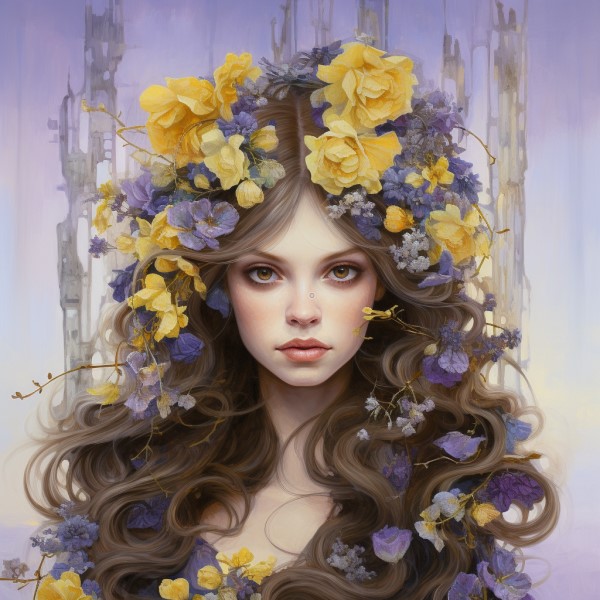Greek Mythology Coloring Pages - Nymphs
Anthousa Coloring Pages
Explore the enchanting world of Greek mythology with our Anthousai coloring pages, capturing the grace and beauty of these flower nymphs in their natural habitat.
The singular form of "Anthousa" is "Anthousa," representing an individual flower nymph in Greek mythology, while the plural form is "Anthousai," referring to a group or collective of these nymphs. In Roman mythology, the equivalent term would be "Flora" for both the singular and plural, aligning with the Roman goddess associated with flowers and spring.
About the Anthousai

In the enchanting realm of Greek mythology, the Anthousai emerge as ethereal nymphs intricately woven into the tapestry of nature. Residing amongst vibrant blooms, these flower nymphs, known for their grace and delicate allure, embody the captivating spirit of the natural world. With petals as their attire and the essence of blossoms intertwined with their existence, the Anthousai, true to their lineage as nymphs, exude an otherworldly charm that invites us to appreciate the harmonious connection between Greek mythology, nymphs, and the mesmerizing realm of flora. As guardians of the floral tapestry, they beckon us to explore the tranquil and mystical landscapes where their presence transforms ordinary flowers into bewitching manifestations of ancient mythology.
Embrace the opportunity to bring the delicate allure of the Anthousai to life in your own creations. Through the art of coloring pages, capture their ethereal grace with serene pastel tones that reflect the subtle beauty of nature's palette. Utilize soft blues and purples to evoke the tranquil ambiance of twilight gardens, blending colors to mirror the gentle transition from dusk to dawn. Infuse your artwork with the dewy freshness of morning gardens, employing pastel pinks, soft yellows, and lush greens to depict the renewing energy of the dawn. Don't forget the vibrant hues of sunny summer gardens, where bold reds, oranges, and bright yellows celebrate the exuberant spirit of midday. Let your imagination unfold as you delve into the tales of the Anthousai, allowing each stroke to reveal the intricate narratives woven by these divine nymphs. Engage with this captivating world, where every color and line brings you closer to the celestial essence of mythology's most enchanting florae, from the mystical twilight to the vibrant daylight.
The Greek Myth of the Aurai
 In a time long past, nestled within the tranquil valleys of ancient Greece, there thrived a group of divine beings known as the Anthousai. These graceful nymphs were the soul of the myriad blossoms that adorned the landscapes, casting a veil of vibrant hues over the earth. While their names rarely graced the grand epics of gods and heroes, the essence of their being was deeply woven into the fabric of the natural world they so tenderly cared for.
In a time long past, nestled within the tranquil valleys of ancient Greece, there thrived a group of divine beings known as the Anthousai. These graceful nymphs were the soul of the myriad blossoms that adorned the landscapes, casting a veil of vibrant hues over the earth. While their names rarely graced the grand epics of gods and heroes, the essence of their being was deeply woven into the fabric of the natural world they so tenderly cared for.
Born from the earth's embrace, the Anthousai were said to have sprung forth from the joyful tears of Chloris, the goddess who personified the splendor of flowers. Overwhelmed by the earth's floral beauty, Chloris's tears of happiness gave life to these enchanting beings. Each Anthousa became a protector and living embodiment of a specific bloom, mirroring its beauty and spirit.
Among their number was Asteria, whose laughter could be heard in the rustling of aster fields, and Iris, a nymph with wings that shimmered like the petals of the iris, bringing their vivid colors to the world. Together with their kin, they danced through the flora, their every move a tribute to the ebb and flow of nature's rhythms.
Though seldom seen by human eyes, the Anthousai played a pivotal role in the mythic narratives of Greece. Legends told of their gentle caresses that infused the earth with unrivaled beauty and life. Mortals fortunate enough to cross paths with these floral guardians were often gifted with profound artistic inspiration and a heartfelt bond with nature.
A time came when the meadows, usually abloom with life, began to dim, mirroring the despair of Demeter, the goddess aggrieved by her daughter Persephone's descent into the underworld. The Anthousai, feeling the weight of Demeter's sorrow and seeing their cherished flowers wither, gathered to forge a plan of hope.
In a union of wisdom and compassion, they chose emissaries to venture into the shadowy realms below. Asteria, renowned for her persuasive eloquence, and Iris, with her captivating beauty, were chosen for this sacred mission. United, the Anthousai imbued them with a protective blessing, their petals entwined in solidarity.
Guided by the gentle breezes and the earth's silent murmurs, Asteria and Iris journeyed to the underworld. Before Hades, they stood, their pleas woven with tales of the world's grief and the fading glory of the flowers above. Moved by their heartfelt entreaties, Hades consented, allowing Persephone to grace the earth with her presence annually, heralding the rejuvenation of spring and the bloom of flowers anew.
With Persephone's return, the meadows once again danced with color, and life's cycle was renewed. The Anthousai, their spirits lifted by their triumph, resumed their eternal dance among the blossoms, guardians of the perpetual beauty and vitality of the natural world. And thus, in the ancient meadows of Greece, the legacy of the Anthousai endured, a testament to their enduring guardianship over nature's delicate balance.






 Clematisia, Anthousa of the Clematis blossom coloring page
Clematisia, Anthousa of the Clematis blossom coloring page Cloveria, Anthousa of the clover blossom coloring page
Cloveria, Anthousa of the clover blossom coloring page Liliantha, Anthousa of the Lily blossom coloring page
Liliantha, Anthousa of the Lily blossom coloring page



